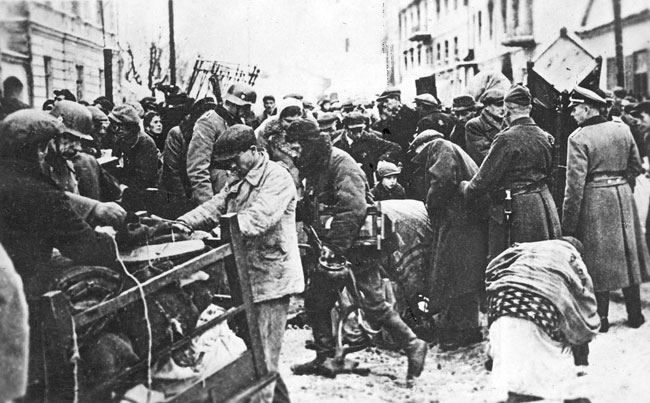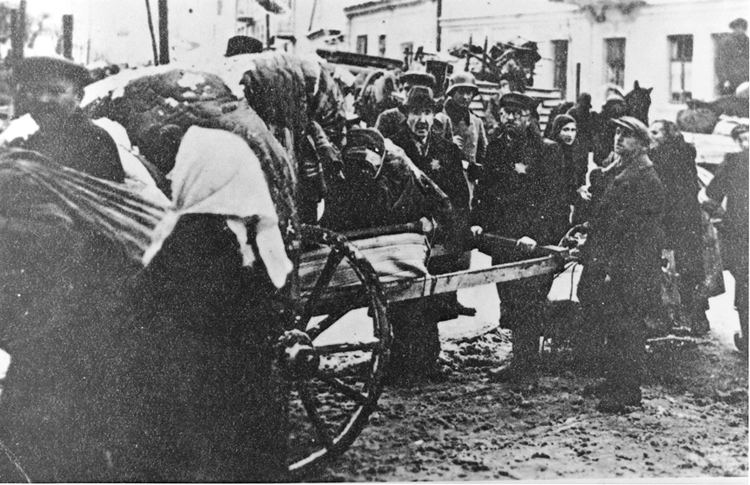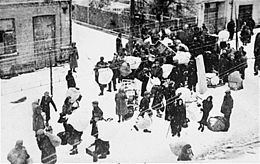Organizations Schutzstaffel (SS) | Camp Treblinka, Auschwitz | |
 | ||
Incident type Imprisonment, forced labor, starvation, transit to extermination camps | ||
The Grodno Ghetto (Polish: getto w Grodnie, Hebrew: עברית) was a World War II ghetto established in November 1941 by Nazi Germany in the city of Grodno for the purpose of persecution and exploitation of Polish Jews in German-occupied eastern Poland. Until the Nazi-Soviet invasion of Poland in 1939 Grodno (now, Belarus) was part of the Białystok Voivodeship of the Second Polish Republic. Following the secret pact signed with Germany, the Soviets annexed the region temporarily in 1939 to the Belarusian SSR in the atmosphere of terror. Grodno was annexed by the Nazis in 1941 to the Bezirk Bialystok district of East Prussia in the course of the German attack on the Soviet positions in eastern Poland codenamed Operation Barbarossa.
Contents

The Ghetto, run by Nazi German Schutzstaffel (SS), consisted of two interconnected units about 2 km apart. The Ghetto One was established in the Old Town district, around the synagogue (Shulhoif), with some 15,000 Jews crammed into an area less than half a square kilometer. The Ghetto Two was created in the Słobódka suburb, with around 10,000 Jews incarcerated in it. Ghetto Two was larger than the main ghetto but far more ruined. The reason for the split was determined by the concentration of Jews within the city and less need to transfer them from place to place. Their situation however, had considerably worsened with the ghettos' locations highly inadequate in terms of sanitation, water and electricity.

The separation of the ghettos would later enable the Germans to exterminate their population with greater ease. The larger ghetto was liquidated in 1943, a year-and-a-half after its establishment, and the smaller one, a few months earlier.

Ghetto One

Twelve days into the German occupation of the city a number of restrictions and prohibitions were enforced by the new administration. All Jews were ordered to register and the word Jude (German for Jew) was stamped into their identity cards. They were forbidden to walk on the sidewalks; and allowed to walk only on roads in a single file. On June 30, 1941, it became mandatory for all Jews to wear an identifying badge.

Ghetto One was established in the city's central part, close to the castle and around the synagogue. Jews had already concentrated in that area before the founding of the ghetto, but the space was greatly reduced nonetheless. All 15,000 Jews living nearby were forced into an area less than half a square kilometer, between Wilenska Street on one side, and Zamkowa Street (renamed Burg Strasse) on the other. The ghetto was surrounded by a 2 metre fence. The entrance to the ghetto was on Zamkowa Street between the sidewalk and the road. Some of the houses on that street were demolished. The total area of the ghetto would shrink in time; as the transports of the Jews went on to the transit camp in Kiełbasin, and then on to the death camp in Treblinka. Just before its closure, Ghetto One included only a few buildings on Zamkowa Street.
Ghetto Two

Ghetto Two was created behind the railway tracks in the Słobódka (Slobodka) suburb, next to the old army barracks near the market square. The neighborhood was underdeveloped, with fewer houses and a lot of empty lots. Some 10,000 Jews were herded into this ghetto, larger in size than Ghetto One but far more dilapidated. They were given only six hours to move in without the use of vehicles, resulting in near panic, with thousands of Jews flooding the gates. The ghetto was surrounded by a fence, which ran along Skidel Street. The entrance to the ghetto was from Artyleryjska Street (renamed Kremer Strasse).

In both ghettos ration cards were introduced in the Jewish bakeries. The Jews received about 200 grams of bread a day for a token payment. The Judenrat was allowed to run a butcher shop with horse meat available from time to time. Potatoes were distributed from the cellar of the Great Synagogue. There were public kitchens in both ghettos serving up to 3,000 meals a day without meat or fat but with a piece of bread (50-100 grams). A separate pot was used for those who wanted kosher food.
Deportations
Mass executions were conducted on November 2, 1942. On the same day, both ghettos were sealed off from the outside by the SS. The first liquidation action took place beginning 15 November 1942 from Ghetto Two. Some 4,000 Jewish tradesmen were transferred to Ghetto One and all remaining prisoners were marched to a Sammellager in nearby Kiełbasin for departure aboard Holocaust trains to Auschwitz-Birkenau. The first deportation train arrived at Birkenau three days later on November 18. Before death, some Jews were ordered to sign postcards in German that read "Being treated well, we are working and everything is fine".
The next deportation action from Ghetto One to transit camp in Kiełbasin (now Kolbasino near Grodno) began at the end of November 1942. In Kiełbasin, the Jews were loaded onto cattle trucks and transported to Auschwitz and Treblinka. In March 1943 more Jews from Ghetto One were sent to Białystok Ghetto. In November 1943 the remaining inmates were either massacred locally or sent for extermination by train to Majdanek and Treblinka, as soon as the courageous Białystok Ghetto Uprising was extinguished.
Rescue efforts
During the ghetto liquidation, there were numerous Jewish escape, and rescue attempts by Catholic Poles. In March 1943, Meir Trachtenberg with his wife and son crossed the ghetto boundary and walked for 20 kilometres (12 mi) to Dulkowszczyzna, where they were rescued by Polish Righteous Anna and Stanisław Krzywicki. All survived. Polish Righteous Krystyna Cywińska who lived in Grodno with two children, was killed in 1943 for saving Jews. She was arrested after one of the Jewish girls at her home, Bella Ilin, went with her daughter Danuta Cywińska back to the ghetto to rescue Bella's mother and brother. Bella (now Shulman) and Danuta were unsuccessful, but lived. Danuta rescued five other Jews soon thereafter. Polish medical doctor Antoni Docha was asked by his prewar colleague Dr. Chaim Blumstein to help him and his family escape. Docha bribed a Polish driver of a big German truck and went to the ghetto along with him. They put a dozen Jews under the rags and tarpaulin including Blumstein and Broide families and successfully crossed several German checkpoints. The driver finally broke down and asked Docha along with everybody else to get out of the lorry. They reached Docha's house in Indura on foot. Antoni Docha and his wife Janina took in more Jews as the time went on. All survived. Many kept corresponding after the war.
Postwar
After World War II, Poland's borders were redrawn, according to the demands made by Josef Stalin at the Yalta Conference of 1945. Grodno (Cyrillic: Гродно; also Hrodna) was then incorporated into the Byelorussian SSR of the Soviet Union. The Polish population was forcibly resettled back within the new borders of Poland before the end of 1946. The Jewish community was never restored. Since 1991, Grodno has been one of the district centres of the Grodno Region in sovereign Belarus. According to Encyclopedia Judaica: "In the mid-1950s the Jewish cemetery was plowed up. Tombstones were taken away and used for building a monument to Lenin."
